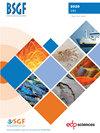Assessing the occurrence of Stegodon and Elephas in China and Southeast Asia during the Early Pleistocene
IF 2.6
3区 地球科学
Q2 GEOSCIENCES, MULTIDISCIPLINARY
引用次数: 6
Abstract
The fossil record is assumed to point to different ecologies, extinction times and ’last stands’ in different regions of the world for Proboscideans, and in some regions, human-proboscidean interaction may theoretically have covered a time span of up to two million years. This paper focuses on the Early Pleistocene of China and Southeast Asia, where the Ailuropoda-Stegodon complex is considered to be a chronologically significant faunal association in the following period. However, the stratigraphic contexts of these local faunal complexes require clarification. Indeed, after one century of research to establish a regional biostratigraphy and in spite of the recomandations provided in the 1980s, many geochronological surveys were undertaken in the 1990s but many problems still exist. Thus, as a first step, taking into consideration the uncertain nature of the geological, taphonomic and chronological data, this paper proposes a critical review of the validity of the associations of Stegodon and Elephas during the Early Pleistocene for this geographical area. Finally, it was necessary to expose what are the current problems before to try to solve them rather than to pursue an unfounded headlong rush. This review concludes that very few reliable data are available and that high-level resolution (MIS) palaeoecological modelization is almost impossible, severely hindering any discussions of strict interaction between humans and proboscideans.中国和东南亚早更新世剑齿象和大象的分布特征
化石记录被认为指向了世界不同地区的不同生态,灭绝时间和“最后的生存”,在一些地区,人类与长鼻猿的相互作用理论上可能涵盖了长达200万年的时间跨度。本文以中国和东南亚早更新世为研究对象,认为翼足类-剑齿虎复合体是该时期具有重要年代学意义的动物类群。然而,这些地方动物复合体的地层背景需要澄清。的确,经过一个世纪建立区域生物地层学的研究,尽管在1980年代提出了建议,但在1990年代进行了许多地质年代学调查,但仍然存在许多问题。因此,作为第一步,考虑到地质、地语学和年代学数据的不确定性,本文对该地理区域早更新世剑齿虎和大象关联的有效性进行了批判性审查。最后,有必要先揭露当前的问题,然后试图解决它们,而不是毫无根据地仓促行事。这篇综述的结论是,可靠的数据很少,高分辨率(MIS)的古生态模型几乎是不可能的,严重阻碍了任何关于人类与长鼻目动物之间严格相互作用的讨论。
本文章由计算机程序翻译,如有差异,请以英文原文为准。
求助全文
约1分钟内获得全文
求助全文
来源期刊
CiteScore
5.80
自引率
0.00%
发文量
18
审稿时长
>12 weeks
期刊介绍:
BSGF - Earth Sciences Bulletin publie plusieurs types de contributions :
1. des articles originaux, couvrant tous les champs disciplinaires des Géosciences, à vocation fondamentale mais également à vocation plus appliquée (risques, ressources);
2. des articles de synthèse, faisant le point sur les avancées dans un domaine spécifique des Géosciences, qu''elles soient méthodologiques ou régionales ;
3. des monographies sur la géologie d’une région donnée, assorties d’informations supplémentaires, cartes, coupes, logs, profils sismiques … publiées en ligne en annexe de l’article ;
4. des articles courts de type « express letter » ;
5. des livrets-guides d’excursion (qui suivront le même processus d’examen éditorial que les articles plus classiques) ;
6. des comptes rendus de campagnes à la mer ;
7. des articles de données géodésiques, géophysiques ou géochimiques, pouvant devenir des articles de référence pouvant conduire à des interprétations ultérieures.
BSGF - Earth Sciences Bulletin constitue également un forum pour les discussions entre spécialistes des Sciences de la Terre, de type comment-reply ou autre. Tous les articles publiés, quelle que soit leur forme, seront accessibles sans frais (articles en Open Access) sur le site de la SGF et sur celui de Geosciences World dans la mesure où les auteurs se seront acquittés d’une contribution de (Article Processing Charges – APC) de 300€ pour les membres de la SGF et 500€ pour les non-membres.

 求助内容:
求助内容: 应助结果提醒方式:
应助结果提醒方式:


